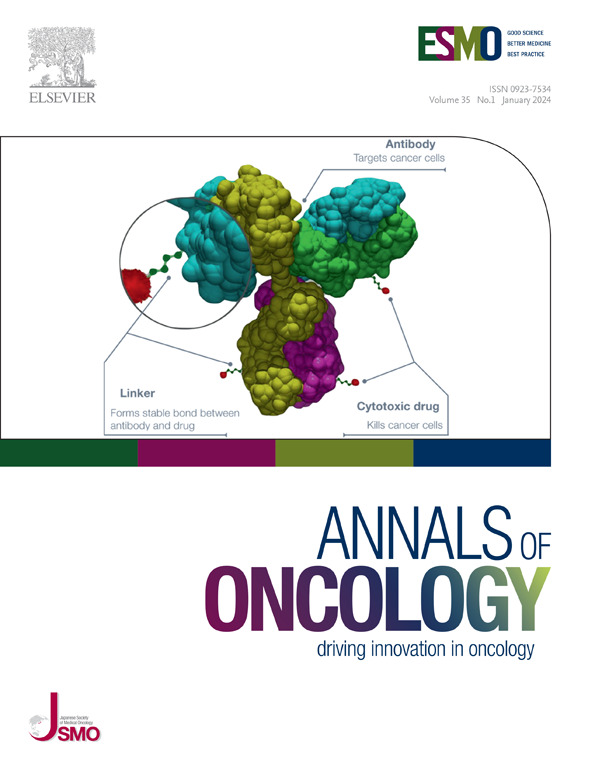Neoadjuvant intralesional targeted immunocytokines (daromun) in stage III melanoma
IF 65.4
1区 医学
Q1 ONCOLOGY
引用次数: 0
Abstract
Background
This phase III trial assessed daromun, a combination of two fibronectin-targeting immunocytokines (L19IL2 and L19TNF), as a neoadjuvant treatment for patients with clinically detectable stage IIIB/C melanoma [American Joint Committee on Cancer (AJCC) version 7].
Patients and methods
Patients were randomized to weekly intralesional daromun administrations (13 million IU of L19IL2 and 400 μg of L19TNF) for 4 weeks followed by surgery, or upfront surgery. Pretreatment with approved adjuvant agents was allowed. The primary endpoint was recurrence-free survival (RFS): events were disease recurrence or death from any cause after complete surgical tumor resection (ClinicalTrials.gov NCT02938299).
Results
A total of 246 patients were randomized and included in the intention-to-treat analysis: 74% had undergone two or more prior surgical resections and 35% had received prior systemic therapy. At a median follow-up of 21 months, the neoadjuvant group (n = 122) had a significantly longer RFS than the upfront surgery group (n = 124), with a median RFS of 16.7 months and 6.8 months, respectively [hazard ratio (HR) 0.59, 95% confidence interval (CI 0.41-0.86), P = 0.005, log-rank test]. The risk of distant recurrence was reduced by 40% in the neoadjuvant arm (HR 0.60, 95% CI 0.37-0.95, P = 0.029). Grade ≥3 treatment-related adverse events (TRAEs) were 6.7% in the surgery-alone arm and 27.1% in the daromun arm, mostly injection site reactions.
Conclusions
Neoadjuvant daromun resulted in a significantly longer RFS than upfront surgery in patients with locally advanced melanoma. TRAEs were transient and manageable. Neoadjuvant daromun is a new therapeutic option for patients with stage III melanoma, including those with locoregional recurrence after surgery and previous adjuvant therapy.
新辅助病灶内靶向免疫细胞因子(Daromun)治疗III期黑色素瘤。
背景:这项3期试验评估了daromun,两种纤维连接蛋白靶向免疫细胞因子(L19IL2和L19TNF)的组合,作为临床可检测的IIIB/C期黑色素瘤(AJCC version 7)患者的新辅助治疗。方法:患者随机接受4周病灶内给药(L19IL2 13 μ IU和L19TNF 400 μg),随后进行手术或术前手术。允许使用批准的佐剂进行预处理。主要终点是无复发生存期(RFS):事件是肿瘤完全手术切除后疾病复发或任何原因导致的死亡。主要发现:246例患者被随机纳入意向治疗分析:74%的患者既往接受过≥2次手术切除,35%的患者既往接受过全身治疗。在中位随访21个月时,新辅助组(N=122)的RFS明显长于术前手术组(N=124),中位RFS分别为16.7个月和6.8个月(HR 0.59;95% CI 0.41 ~ 0.86, p=0.005, log-rank检验)。新辅助组远处复发的风险降低了40% (HR=0.60;95% ci [0.37;0.95);p = 0.029)。≥3级治疗相关不良事件(TRAEs)在单独手术组为6.7%,在达罗蒙组为27.1%,主要是注射部位反应。结论:在局部晚期黑色素瘤患者中,新辅助达莫门的RFS明显长于术前手术。贸易逆差是暂时的,可控的。新辅助达莫门是III期黑色素瘤患者的一种新的治疗选择,包括手术后局部复发和既往辅助治疗的患者。
本文章由计算机程序翻译,如有差异,请以英文原文为准。
求助全文
约1分钟内获得全文
求助全文
来源期刊

Annals of Oncology
医学-肿瘤学
CiteScore
63.90
自引率
1.00%
发文量
3712
审稿时长
2-3 weeks
期刊介绍:
Annals of Oncology, the official journal of the European Society for Medical Oncology and the Japanese Society of Medical Oncology, offers rapid and efficient peer-reviewed publications on innovative cancer treatments and translational research in oncology and precision medicine.
The journal primarily focuses on areas such as systemic anticancer therapy, with a specific emphasis on molecular targeted agents and new immune therapies. We also welcome randomized trials, including negative results, as well as top-level guidelines. Additionally, we encourage submissions in emerging fields that are crucial to personalized medicine, such as molecular pathology, bioinformatics, modern statistics, and biotechnologies. Manuscripts related to radiotherapy, surgery, and pediatrics will be considered if they demonstrate a clear interaction with any of the aforementioned fields or if they present groundbreaking findings.
Our international editorial board comprises renowned experts who are leaders in their respective fields. Through Annals of Oncology, we strive to provide the most effective communication on the dynamic and ever-evolving global oncology landscape.
 求助内容:
求助内容: 应助结果提醒方式:
应助结果提醒方式:


